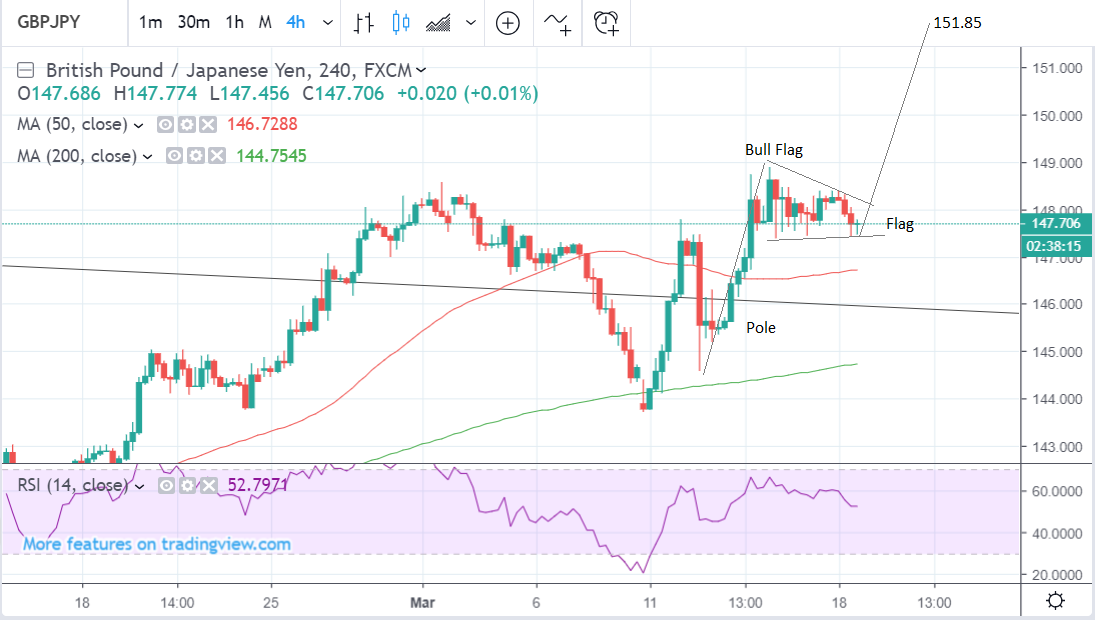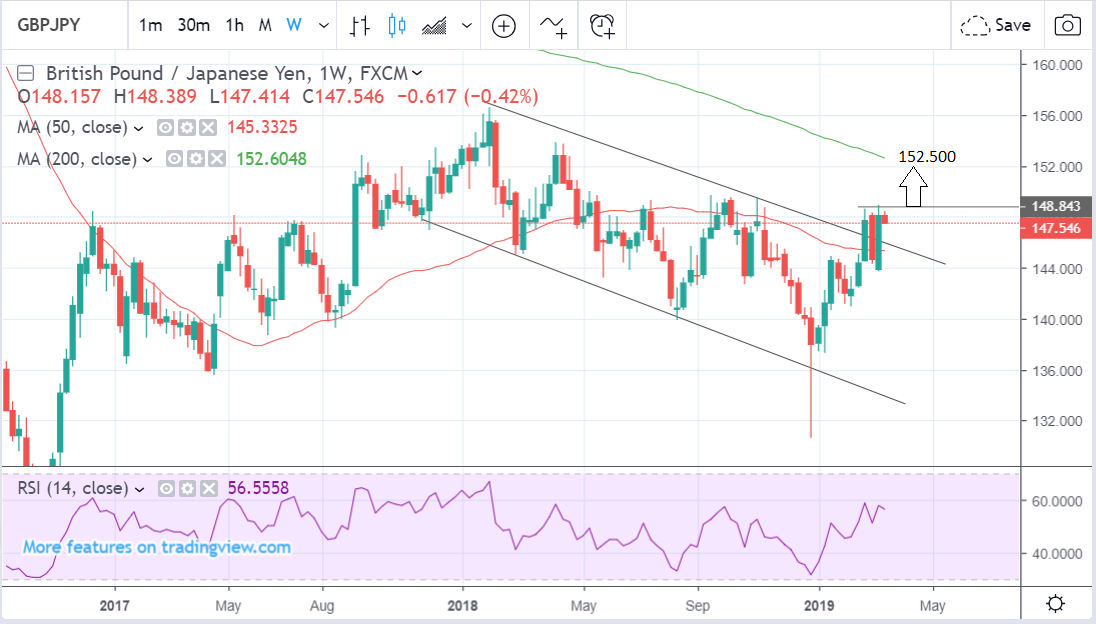The Pound-to-Yen Rate in the Week Ahead: Explosive Breakout in the Cards

Image © Adobe Stock
- GBP tests top of wedge formation on charts
- Creating scope for an explosive break higher
- Brexit main event for GBP; BoJ is up for JPY
The Pound-to-Yen rate was trading at 147.70 on Monday after rising 2.4% from a week ago, although technical studies of the charts suggest there is ample scope for the Pound to post another impressive gain during the days ahead.
Sterling rose against most rivals last week as a result of the option of a ‘no-deal’ Brexit being taken off the table. UK Parliament first voted to reject Theresa May’s deal again, then rejected the possibility of a hard-Brexit, and finally approved an extension to article 50, which could mean Brexit is delayed.
The Pound-to-Yen rate has moved in volatile swings recently, breaking out of the top of its wedge pattern, then pulling back down inside of it before breaking higher again. However, and purely from a technical perspective, the charts suggest more gains are likely and that a break above February's highs could even be in prospect.

Above: Pound-to-Yen rate shown at 4-hour intervals.
The pair has formed a bull-flag pattern on the 4-hour chart ,which is composed of a steep rally that forms the ‘pole’, followed by a consolidation period that is denoted by a flag-looking formation.
This indicates further gains are on the horizon if the pair can break above the 148.87 high established in February. Such a move could be expected to see a carry-through that takes the market up to 151.85.

Above: Pound-to-Yen rate shown at weekly intervals.
The pair has continued to push up against the top of a long bullish wedge pattern in recent trading, suggesting the potential for a breakout and continuation higher. A break out from a large wedge like the one on the GBP/JPY chart is likely to prompt a strong rally higher.
Confirmation of a bullish extension would come from a break above the 148.87 highs, just as is the case for the bull flag. After that, the 152.50 level, which is also the location of the 200-week moving-average, will be in the market's crosshairs.
The only bearish sign on the charts currently is the ‘stick sandwich’ candlestick pattern which has formed on the weekly chart close to recent highs. This is composed of a long down week, which is sandwiched between two long up weeks.
The pattern is a bearish reversal signal, yet on its own it's not enough to alter our bullish forecast.
Above: Pound-to-Yen rate shown at weekly intervals. Captures sandwhich stick pattern.
AA
The Japanese Yen: What to Watch
The main event for the Yen is probably the release of the minutes of the previous week’s Bank of Japan (BOJ) policy meeting, out on Tuesday at 23.50 GMT.
The BOJ made no change to their policy settings at the meeting and kept forward guidance the same, stating that they saw the economy “expanding moderately”.
Yet not all analysts agree. Some even argue the economy is really contracting and the BOJ may have to cut rates rather than hike them. It will be instructive to see what the minutes of the meeting say, therefore, in relation to the possibility of a rate cut. If there was any mention amongst policy-makers it could lead to a fall in the Yen.
“While the BoJ continues to believe that “Japan’s economy is expanding moderately”, we’re more pessimistic about the outlook. If we’re right about the economy, there may be growing talk of the need for further policy easing. All else equal, a more accommodative BoJ would be negative for the yen,” says Nikhil Sanghani, an economist at Capital Economics.
The other main factor likely to impact on the Yen is global risk appetite and geopolitics. To this end the conflict between Indian and Pakistan over disputed territory in Kashmir may be significant. An escalation in conflict could impact negatively on risk appetite and lead to an appreciation in the Yen on the back of cresting safe-haven demand.
Currently, the enmity between the two nations appears to have eased. Another potential geopolitical influence may come from the progress of trade talks between China and the U.S.
A breakthrough is unlikely in the next week, however, based on comments made by Treasury Secretary Steven Mnuchin, who recently said, that although they had made a “lot of progress” it was more important to get “the right agreement and not rush it”. This suggests a breakthrough in talks may take longer than a week.
Even Brexit may impact global risk flows. If Theresa May finally gets her deal voted through on a possible third attempt the Yen could lose ground on the relief (leading to an even sharper rally higher for GBP/JPY).
On the hard data front, inflation data is the main release. Core inflation is expected to come out at 0.8% in February when it is released on Thursday at 23.30 GMT. This is the same level it was at in January. The main risk is a miss, in which case the Yen will probably decline amidst greater calls for even more accommodative policy.
AA
The Pound: What to Watch
The main fundamental driver for the Pound in the week ahead is probably developments in the Brexit process, with the Bank of England (BOE) meeting on Thursday also likely to cause volatility.
It is highly likely that the government will try, for the third time, to get its Brexit deal approved by Parliament, or failing that, that the EU will require a lengthy delay of article 50.
The latest reports from Brussels are suggesting the EU may try to make a delay conditional on either the UK having a second referendum, a general election or a very firm plan.
It is suggested this may focus minds, especially amongst Brexiteers who could fear a hijacking of Brexit if there is a delay. This will put pressure on them to accept the government’s negotiated deal.
The two most likely scenarios, therefore, are that Theresa May’s deal finally gets approved on a third attempt, or that Brexit is delayed on the condition of a referendum or general election being held.
Both would be very positive for the Pound, which compliments the overall bullish technical outlook.
The BOE meeting on Thursday, at 12.00 GMT, could also impact on Sterling. There is a risk the BOE may change its statement to reflect the recent slowdown in the economy. If so the Pound is likely to suffer.
Up until now, it had been assumed Brexit risks were the only thing stopping the BOE from raising interest rates, but the slowing economy may be providing them with other reasons not to.
“The economy has no doubt slowed but the Bank seems unwilling to shift to a more dovish stance, reasoning that it should just be patient for now as an ‘orderly’ Brexit outcome can dispel much of the uncertainty by itself and hence, kickstart investment and growth. Overall, the BoE is unlikely to deviate much from this stance, but if there is any change, it’ll probably be towards a more cautious bias,” says Raffi Boyadjian, an economist at XM.com.
From a purely hard data perspective, the main releases are employment data out on Tuesday, inflation data out on Wednesday and retail sales on Thursday.
Labour market data is expected to continue showing signs of strength, when released on Tuesday at 9.30. The unemployment claimant count is expected to have risen by only 2.7k in February - a relatively low count - the unemployment rate is forecast to be stuck at a historic low of 4.0% in January, and overall payroll count to have risen by 120k in December, according to the market consensus.
More important for Sterling, perhaps, is average earnings in January, since this has more influence over Bank of England (BOE) policy.
If average earnings rise more than the 3.4% in January (3.2% including bonuses) that is forecast, inflation will probably rise and so will interest rates - with expectations increasing that the BOE will raise them, and this will drive Sterling higher. Higher interest rates are positive for the Pound because they attract and keep greater inflows of foreign capital.
Inflation is out on Wednesday and is another key metric for the Pound. As explained above inflation influences BOE policy which impacts on the currency. In January inflation came out surprisingly lower after falling -0.8% compared to December. If inflation is also shown to be negative in February it could really drive down the Pound. Current expectations, however, are for a 0.2% rise.
Thursday sees another major data release, in the form of retail sales in February, out at 9.30. This is forecast to show a -0.3% fall from 1.0% previously. A deeper-than-expected decline, however, could trigger more weakness for Sterling.
Time to move your money? Get 3-5% more currency than your bank would offer by using the services of foreign exchange specialists at RationalFX. A specialist broker can deliver you an exchange rate closer to the real market rate, thereby saving you substantial quantities of currency. Find out more here. * Advertisement
